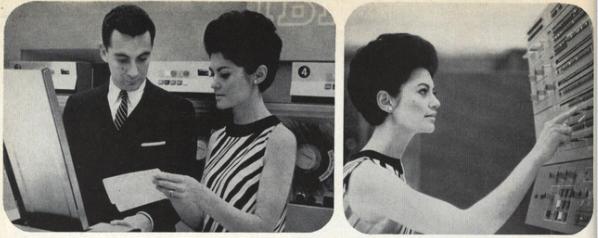The Rise and Fall (and Rise Again) of Women in the Computer Programming Business
To Boldly Go

We talked a while ago about the fact that women were way more involved in the early days of coding than we commonly hear about these days. In reality, in the early days of computing women flocked to the career; it was even marketed to them in Cosmopolitan and throughout the mid-sixties as “women’s work.” This was for a variety of reasons, as were the possibilities behind why women left the field in droves over the following decades, and for their return now. Follow the jump for the statistics, from Fog Creek Software, behind these trends.
In its inception, the field of computer programming was in desperate need of bodies–people who had the aptitude, whether they were men or women.
Partly, it was the fact that programming work itself was not yet fully defined as a scientific or engineering field. In fact, many computer science programs were first housed within a variety of departments and colleges, including liberal arts colleges where women had already made cultural inroads. Not least of all — and you knew this was coming — women quickly noticed that some programming work could be done at home while the children were napping.
1987 saw 42% of the software designers in America as women, and 34% of the systems analysts. Between 1984 and 2006, however, the number of women majoring in Computer Science dropped from 37% to 20%. It should also be noted that all of this was taking place “just as the percentages of women were increasing steadily in all other fields of science, technology, engineering, and math, with the possible exception of physics,” but the reasons behind the female abandonment of the Computer Science field are interesting.
One of the most prevalent of those reasons came with a stereotype that arose around the time of the personal computer boom–that of the “eccentric, antisocial, male hacker.” The basic expectations of “who” went into the computer programming field shifted with that, and with that the women shifted focus as well.
These days, though, the number of women in the field is back on the rise, with female Computer Science majors at Harvard nearly doubling, with similar trends spotted at MIT and Carnegie Mellon–it’s at 25% at Harvard now, which is still shy of1984’s 37%, but a lot better than 13%, which was the previous percentage.
Fog Creek Software, in particular, has documented the gender patterns in their hiring process–although they couldn’t ask applicants their gender, and therefore guessed based on first name.
In response to their hiring patterns, this is what they said:
We know that, even if the number of women majoring in Computer Science is really on the rise, it will probably take some time before we see such an increase fully reflected in the number of female applicants we attract and hire. At the same time, we’re committed to targeting as many female computer science majors as possible in our recruitment efforts.
They also conducted an interview with one of their female interns about her experience as a woman in computer science. You can read that here.
(via Fog Creek Software)
Have a tip we should know? tips@themarysue.com